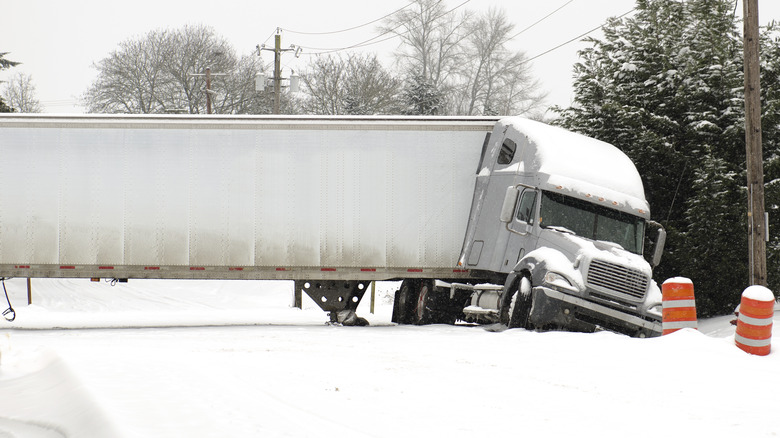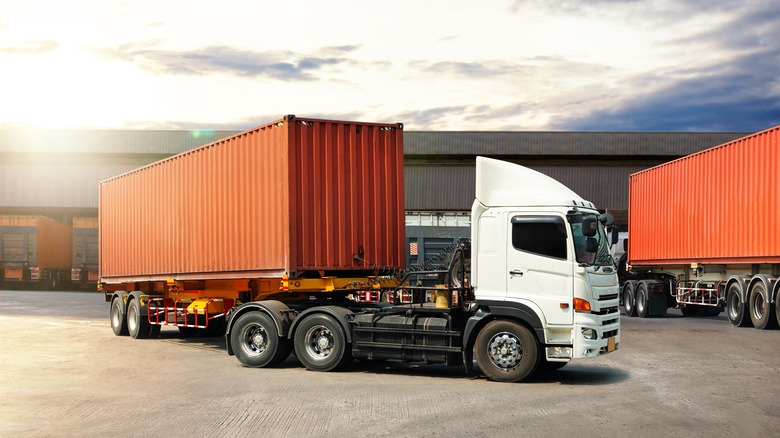What Does It Mean When A Semi-Truck Jackknifes? Here's What Happens
Semi-trucks with a gross vehicle weight rating (GVWR) over 33,000 pounds are classified as class 8 vehicles by the Federal Highway Administration. The term semi-truck actually refers to the trailer, and the tractor-trailer combination can weigh as much as 80,000 pounds fully loaded. The trailer on a semi-truck is pulled by the tractor and doesn't have any propulsion system of its own, although most have brakes. Since the bulk of the weight of a loaded semi is in the trailer, drivers need plenty of skill and a cautious manner to avoid accidents. Alarmingly, semi-truck related accidents have been on the rise. According to the Insurance Institute for Highway Safety (IIHS), accidents involving large trucks killed 4,714 people in 2022, a 17% increase from the year before.
Jackknifing is a common mishap associated with semi-trucks. As the name suggests, a jackknife happens when the trailer pivots on the coupling, forming a V shape that resembles a folded jackknife. In some cases, the driver can lose control over the vehicle and the semi-truck can go off the road or overturn. A semi-truck jackknife can happen due to a variety of reasons, including careless driving or equipment failure. Here's what causes a jackknife and what you can do to avoid the situation.
Semi-truck operation is a delicate practice
The trailer on a semi-truck gains and loses momentum in response to the driver's maneuvering of the tractor. The long distance between the wheels on the tractor and trailer forcess the driver to constantly balance the two halves while accelerating, turning, or slowing down. A common reason that causes semi-trucks to jackknife is braking too hard. Fully loaded semi-trucks need a long stopping distance due to their weight. When a driver pushes the brakes too hard — especially if the tractor and trailer aren't lined up correctly — the trailer can exert enough lateral force to overcome the power of the tractor. The tail end of the trailer swings on the coupling, pushing or pulling the rear of the tractor hard enough to send it into a skid.
Another common cause is driving too fast around curves or on slippery surfaces. These conditions can also cause the trailer to swing out, upsetting the tractor-trailer's equilibrium. Tire blowouts or loose or damaged couplings can also cause the trailer or tractor to change directions abruptly, causing a jackknife. Drivers can often get out of an impending jackknife with gentle use of the accelerator as the rear end starts to swing. Even drivers of regular cars can help prevent jackknifes by giving semi-trucks plenty of room on the road, especially in slippery conditions.
Avoiding a semi-truck jackknife
Deadline pressure can cause professional semi-truck drivers to hit the throttle hard and drive faster than they should. However, driving slowly and keeping a safe following distance are key to avoiding jackknifes and other accidents from happening. The Federal Motor Carrier Safety Administration proposed electronically limiting semi-truck speeds to 68 miles per hour, but thousands of complaints forced the agency to remove the 68 mph figure from the rule. Driving carefully and slowing down around curves and on slippery surfaces prevents excessive swaying of the trailer and the tractor. Remember, tractor-trailers require much longer braking distances than cars. Tractor-trailer drivers should also inspect the coupling before driving and check for these important signs that tires need replacing.
If you tow a boat, RV, or other trailer, you also need to be careful to avoid jackknifing. A trailer jackknife (in which the trailer brakes lock up causing a skid) often happens slowly and is much easier to control. Keep your foot off the brake, and slowly feather the throttle. The forward motion should bring the trailer to align with the powered vehicle. A tractor jackknife (in which the tractor or tow vehicle sways) can happen very quickly and is harder to drive out of. Avoid the throttle and brake, and counter-steer gently to re-align the powered vehicle with the trailer.


